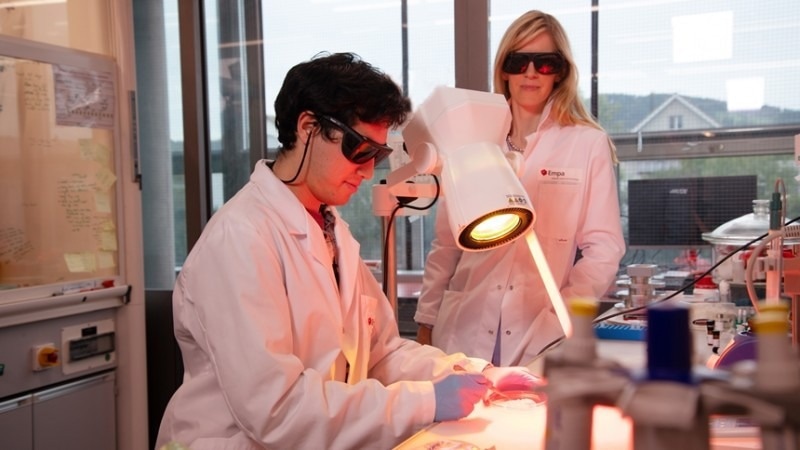Researchers from Empa and ETH Zurich have introduced a new technique for wound closure in a recent study published in the journal Small Methods. Utilizing a novel laser soldering approach, the team has developed a method that uses metallic and ceramic nanoparticles for precise temperature control, offering a safer and more effective alternative to traditional suturing.
 Soldering wounds with a nanoparticle paste and light: Oscar Cipolato and Inge Herrmann in Empa’s Particles-Biology In-teractions laboratory in St. Gallen. Image Credit: Empa
Soldering wounds with a nanoparticle paste and light: Oscar Cipolato and Inge Herrmann in Empa’s Particles-Biology In-teractions laboratory in St. Gallen. Image Credit: Empa
Suturing a wound with a needle and thread was invented by man more than 5,000 years ago. This surgical premise has not altered much since then: incisions or tears in the tissue can be put together more or less properly depending on the fingertip sensation of the person doing the surgery and the instruments. Once both sides of a wound are properly attached to one other, the body might naturally begin to repair the tissue gap.
Nevertheless, the purpose of the suture is not always fulfilled: the thread has the potential to pierce extremely fragile tissues and result in further harm. Permeable sutures can also be a potentially fatal issue if the wound closure fails to close around internal organs.
Controlling Temperature in Real Time
Typically, soldering is the process of fusing materials with heat and a melting bonding substance. Applications of soldering procedures in medicine have been hindered by the requirement that this thermal reaction stay within very specific bounds for biological materials, as well as the difficulty of measuring the temperature non-invasively.
Therefore, the group headed by Oscar Cipolato and Inge Herrmann from the Nanoparticle Systems Engineering Laboratory at ETH Zurich and the Particles Biology Interactions laboratory at Empa in St. Gallen played around with an intelligent wound closure system that allows laser soldering to be efficiently and gently controlled.
For this reason, they created a bonding agent using metallic and ceramic nanoparticles, utilizing nanothermometry to regulate the temperature.
The interplay of the two types of nanoparticles in the bonding protein-gelatin paste is another factor contributing to the novel soldering technique’s elegance. Titanium nitride nanoparticles absorb light and transform it into heat when the paste is exposed to laser radiation. On the other hand, the pastes specifically created bismuth vanadate particles that function as microscopic fluorescent nanothermometers.
They emit a particular wavelength of light in a temperature-dependent way, enabling incredibly accurate real-time temperature control. This makes the technique especially well-suited for application in minimally invasive surgery, as it can detect temperature variations in both superficial and deep wounds with incredibly fine spatial precision, all without the need for stirring.
Gentle IR
After optimizing the settings for “iSoldering” (English for intelligent soldering) using mathematical modeling in silico, the researchers were able to analyze the composite material’s performance. In laboratory testing using diverse tissue samples, the team collaborated with surgeons from the University Hospital Zurich, the Cleveland Clinic (USA), and the Czech Charles University to accomplish quick, stable, and biocompatible wound bonding on organs such as the pancreas and liver.
Using iSoldering to seal especially difficult tissue sections, including the urethra, fallopian tube, or intestines, was equally effective and delicate. The nanoparticle composite material has now been the subject of a patent application.
Not content to stop there, the researchers managed to swap out the harsh laser light source for a softer infrared (IR) light source. This advances the science of soldering one step closer to its application in hospitals.
If medically approved IR lamps were applied, the innovative soldering technology could be used in conventional operating rooms without additional laser protection measures.
Inge Herrmann, Researcher, Swiss Federal Laboratories for Materials Science and Technology (Empa)
Journal Reference:
Cipolato, O., et. al. (2023) Nanothermometry-Enabled Intelligent Laser Tissue Soldering. Small Methods. doi:10.100l2/smtd.202300693.
Source: https://www.empa.ch/